O'Meara Electronics Case: Strategies for Performance & Remuneration
VerifiedAdded on 2023/06/13
|16
|2881
|252
Case Study
AI Summary
This case study delves into the challenges faced by O'Meara Electronics, focusing on declining profitability and market position due to issues in performance and remuneration management. The report analyzes the company's existing systems and proposes an Integrated Development System (IDS) to address these concerns. The IDS is designed to align company resources, improve organizational effectiveness, and encourage employee motivation through performance-related incentives. It also emphasizes the importance of international strategies of management and a shift towards a person-based remuneration system. The report further compares the IDS with the Service Delivery Budget Implementation System, ultimately recommending the implementation of both systems to enhance performance measurement and employee compensation. The proposed solutions aim to improve O'Meara Electronics' overall performance and market competitiveness.
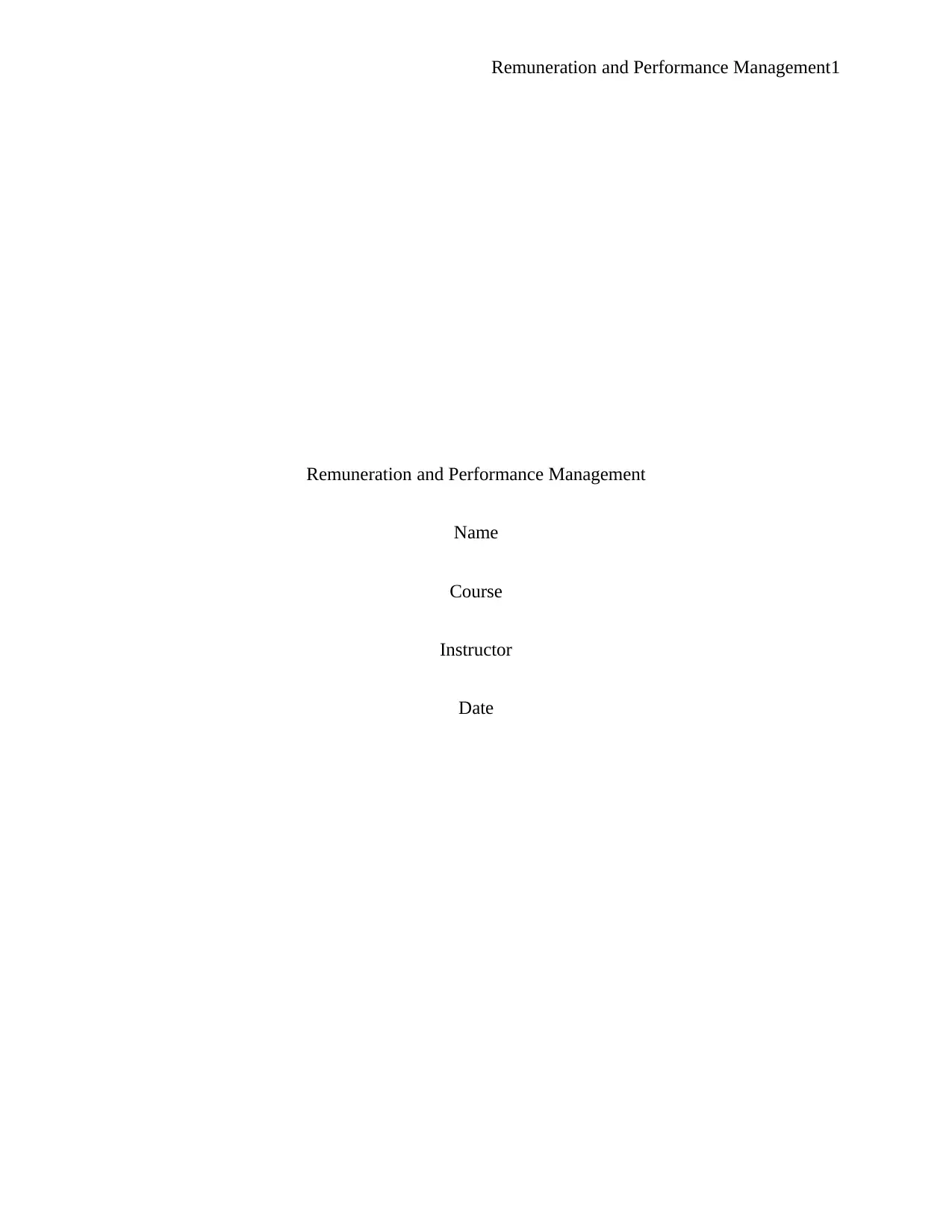
Remuneration and Performance Management1
Remuneration and Performance Management
Name
Course
Instructor
Date
Remuneration and Performance Management
Name
Course
Instructor
Date
Paraphrase This Document
Need a fresh take? Get an instant paraphrase of this document with our AI Paraphraser
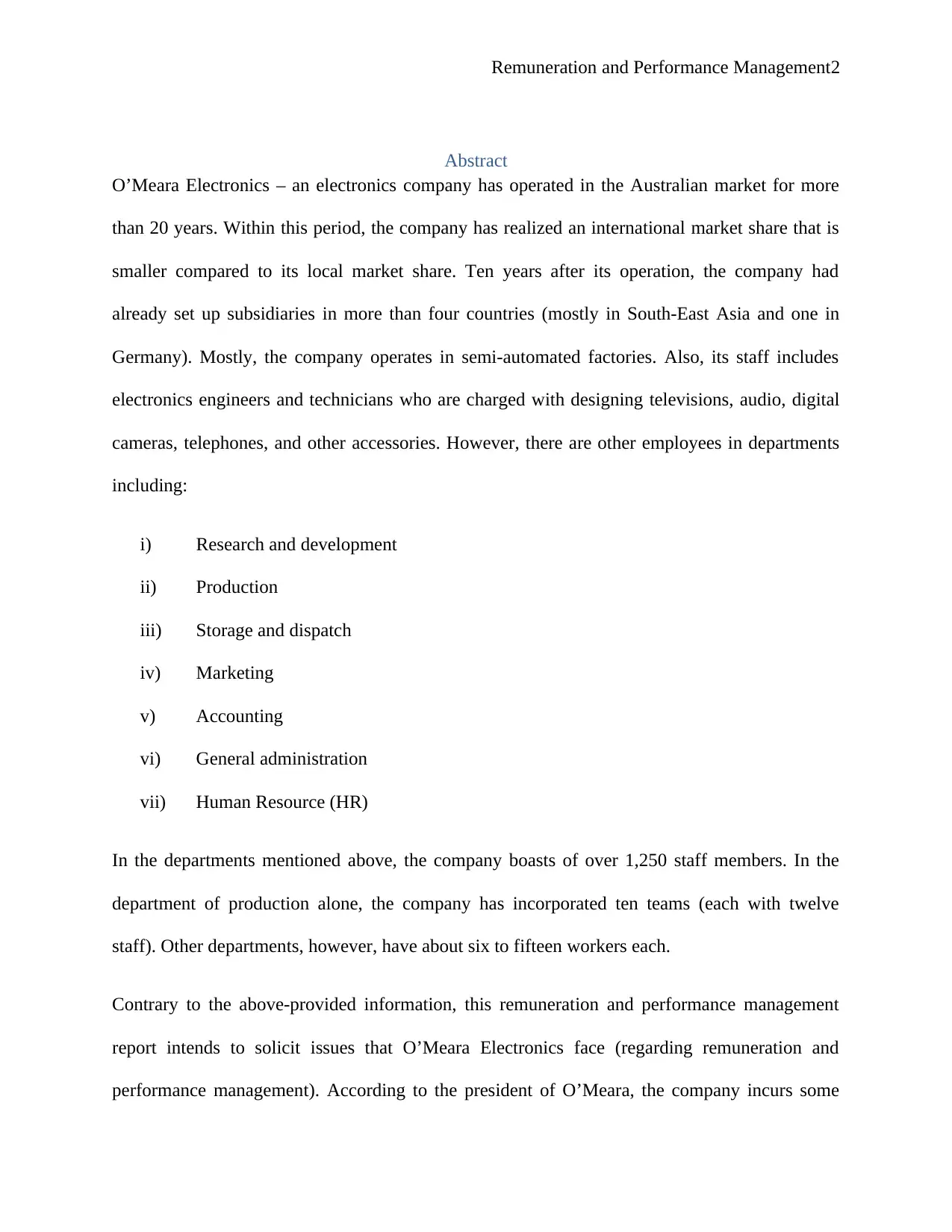
Remuneration and Performance Management2
Abstract
O’Meara Electronics – an electronics company has operated in the Australian market for more
than 20 years. Within this period, the company has realized an international market share that is
smaller compared to its local market share. Ten years after its operation, the company had
already set up subsidiaries in more than four countries (mostly in South-East Asia and one in
Germany). Mostly, the company operates in semi-automated factories. Also, its staff includes
electronics engineers and technicians who are charged with designing televisions, audio, digital
cameras, telephones, and other accessories. However, there are other employees in departments
including:
i) Research and development
ii) Production
iii) Storage and dispatch
iv) Marketing
v) Accounting
vi) General administration
vii) Human Resource (HR)
In the departments mentioned above, the company boasts of over 1,250 staff members. In the
department of production alone, the company has incorporated ten teams (each with twelve
staff). Other departments, however, have about six to fifteen workers each.
Contrary to the above-provided information, this remuneration and performance management
report intends to solicit issues that O’Meara Electronics face (regarding remuneration and
performance management). According to the president of O’Meara, the company incurs some
Abstract
O’Meara Electronics – an electronics company has operated in the Australian market for more
than 20 years. Within this period, the company has realized an international market share that is
smaller compared to its local market share. Ten years after its operation, the company had
already set up subsidiaries in more than four countries (mostly in South-East Asia and one in
Germany). Mostly, the company operates in semi-automated factories. Also, its staff includes
electronics engineers and technicians who are charged with designing televisions, audio, digital
cameras, telephones, and other accessories. However, there are other employees in departments
including:
i) Research and development
ii) Production
iii) Storage and dispatch
iv) Marketing
v) Accounting
vi) General administration
vii) Human Resource (HR)
In the departments mentioned above, the company boasts of over 1,250 staff members. In the
department of production alone, the company has incorporated ten teams (each with twelve
staff). Other departments, however, have about six to fifteen workers each.
Contrary to the above-provided information, this remuneration and performance management
report intends to solicit issues that O’Meara Electronics face (regarding remuneration and
performance management). According to the president of O’Meara, the company incurs some

Remuneration and Performance Management3
management issues that are likely to affect its operation and success. As put by the president, the
issues have already led to the decline of O’Meara’s market position as well as its profitability.
Such a case, therefore, contributes to the unanimous decree to rationalize several operational
areas including changes in performance management and remuneration strategies. There are
some ideas put across by the stakeholders to ensure that the outlaid objectives are achieved.
Among such ideas is the development of international strategies of management (with regards to
legislative requirements and country practices). Another idea put across is the changing of the
company’s position-based remuneration system to a more advanced person-based system.
management issues that are likely to affect its operation and success. As put by the president, the
issues have already led to the decline of O’Meara’s market position as well as its profitability.
Such a case, therefore, contributes to the unanimous decree to rationalize several operational
areas including changes in performance management and remuneration strategies. There are
some ideas put across by the stakeholders to ensure that the outlaid objectives are achieved.
Among such ideas is the development of international strategies of management (with regards to
legislative requirements and country practices). Another idea put across is the changing of the
company’s position-based remuneration system to a more advanced person-based system.
⊘ This is a preview!⊘
Do you want full access?
Subscribe today to unlock all pages.

Trusted by 1+ million students worldwide
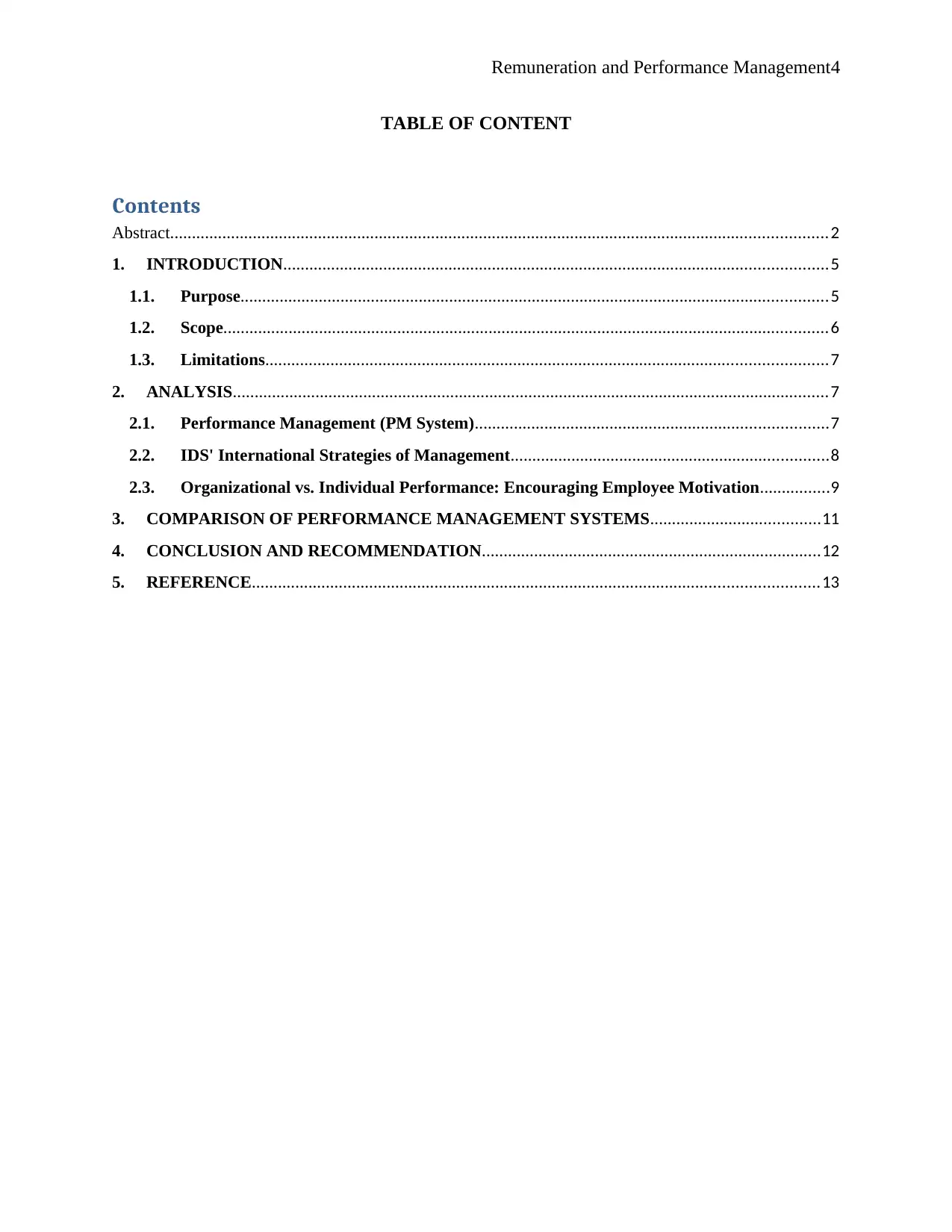
Remuneration and Performance Management4
TABLE OF CONTENT
Contents
Abstract.......................................................................................................................................................2
1. INTRODUCTION.............................................................................................................................5
1.1. Purpose.......................................................................................................................................5
1.2. Scope...........................................................................................................................................6
1.3. Limitations.................................................................................................................................7
2. ANALYSIS.........................................................................................................................................7
2.1. Performance Management (PM System).................................................................................7
2.2. IDS' International Strategies of Management.........................................................................8
2.3. Organizational vs. Individual Performance: Encouraging Employee Motivation................9
3. COMPARISON OF PERFORMANCE MANAGEMENT SYSTEMS.......................................11
4. CONCLUSION AND RECOMMENDATION..............................................................................12
5. REFERENCE..................................................................................................................................13
TABLE OF CONTENT
Contents
Abstract.......................................................................................................................................................2
1. INTRODUCTION.............................................................................................................................5
1.1. Purpose.......................................................................................................................................5
1.2. Scope...........................................................................................................................................6
1.3. Limitations.................................................................................................................................7
2. ANALYSIS.........................................................................................................................................7
2.1. Performance Management (PM System).................................................................................7
2.2. IDS' International Strategies of Management.........................................................................8
2.3. Organizational vs. Individual Performance: Encouraging Employee Motivation................9
3. COMPARISON OF PERFORMANCE MANAGEMENT SYSTEMS.......................................11
4. CONCLUSION AND RECOMMENDATION..............................................................................12
5. REFERENCE..................................................................................................................................13
Paraphrase This Document
Need a fresh take? Get an instant paraphrase of this document with our AI Paraphraser
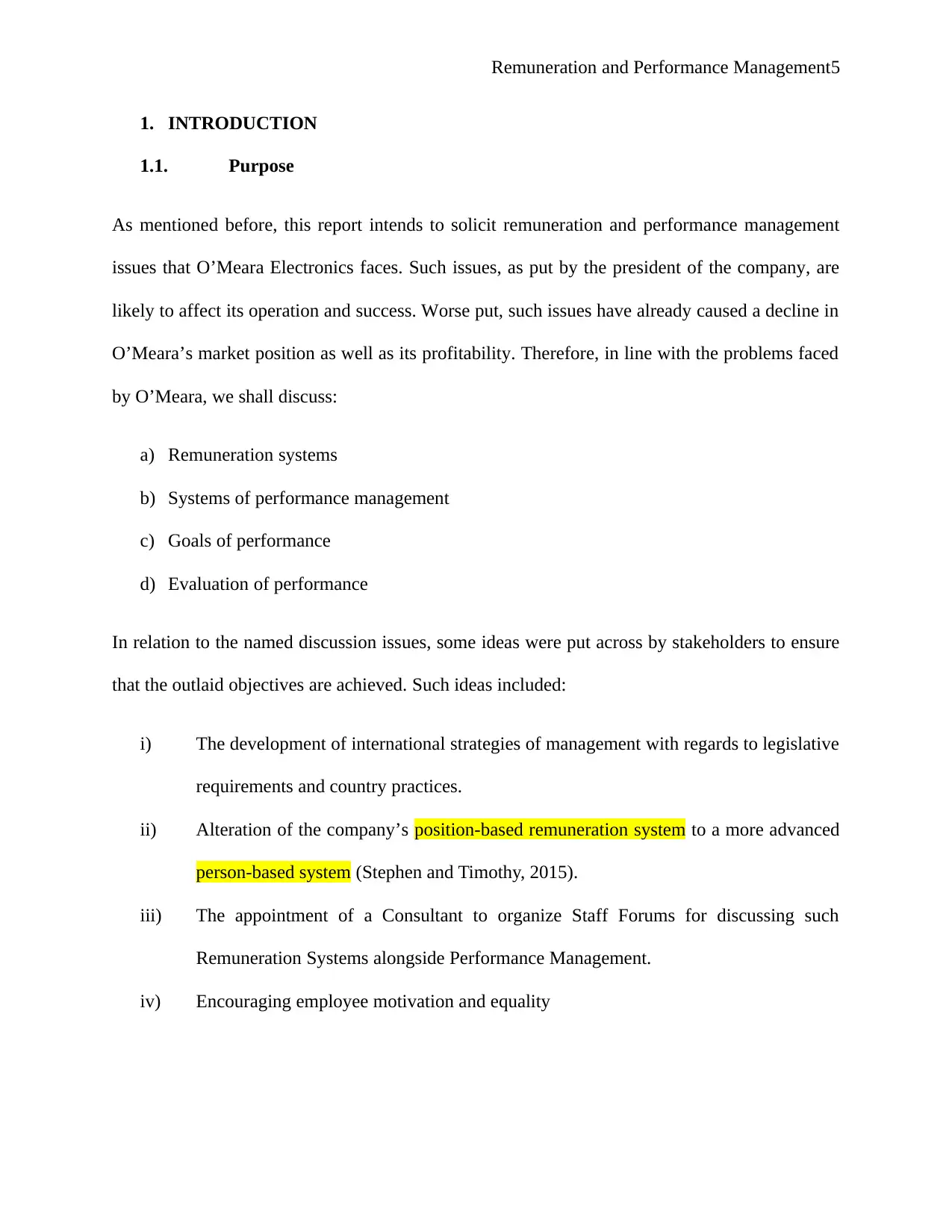
Remuneration and Performance Management5
1. INTRODUCTION
1.1. Purpose
As mentioned before, this report intends to solicit remuneration and performance management
issues that O’Meara Electronics faces. Such issues, as put by the president of the company, are
likely to affect its operation and success. Worse put, such issues have already caused a decline in
O’Meara’s market position as well as its profitability. Therefore, in line with the problems faced
by O’Meara, we shall discuss:
a) Remuneration systems
b) Systems of performance management
c) Goals of performance
d) Evaluation of performance
In relation to the named discussion issues, some ideas were put across by stakeholders to ensure
that the outlaid objectives are achieved. Such ideas included:
i) The development of international strategies of management with regards to legislative
requirements and country practices.
ii) Alteration of the company’s position-based remuneration system to a more advanced
person-based system (Stephen and Timothy, 2015).
iii) The appointment of a Consultant to organize Staff Forums for discussing such
Remuneration Systems alongside Performance Management.
iv) Encouraging employee motivation and equality
1. INTRODUCTION
1.1. Purpose
As mentioned before, this report intends to solicit remuneration and performance management
issues that O’Meara Electronics faces. Such issues, as put by the president of the company, are
likely to affect its operation and success. Worse put, such issues have already caused a decline in
O’Meara’s market position as well as its profitability. Therefore, in line with the problems faced
by O’Meara, we shall discuss:
a) Remuneration systems
b) Systems of performance management
c) Goals of performance
d) Evaluation of performance
In relation to the named discussion issues, some ideas were put across by stakeholders to ensure
that the outlaid objectives are achieved. Such ideas included:
i) The development of international strategies of management with regards to legislative
requirements and country practices.
ii) Alteration of the company’s position-based remuneration system to a more advanced
person-based system (Stephen and Timothy, 2015).
iii) The appointment of a Consultant to organize Staff Forums for discussing such
Remuneration Systems alongside Performance Management.
iv) Encouraging employee motivation and equality
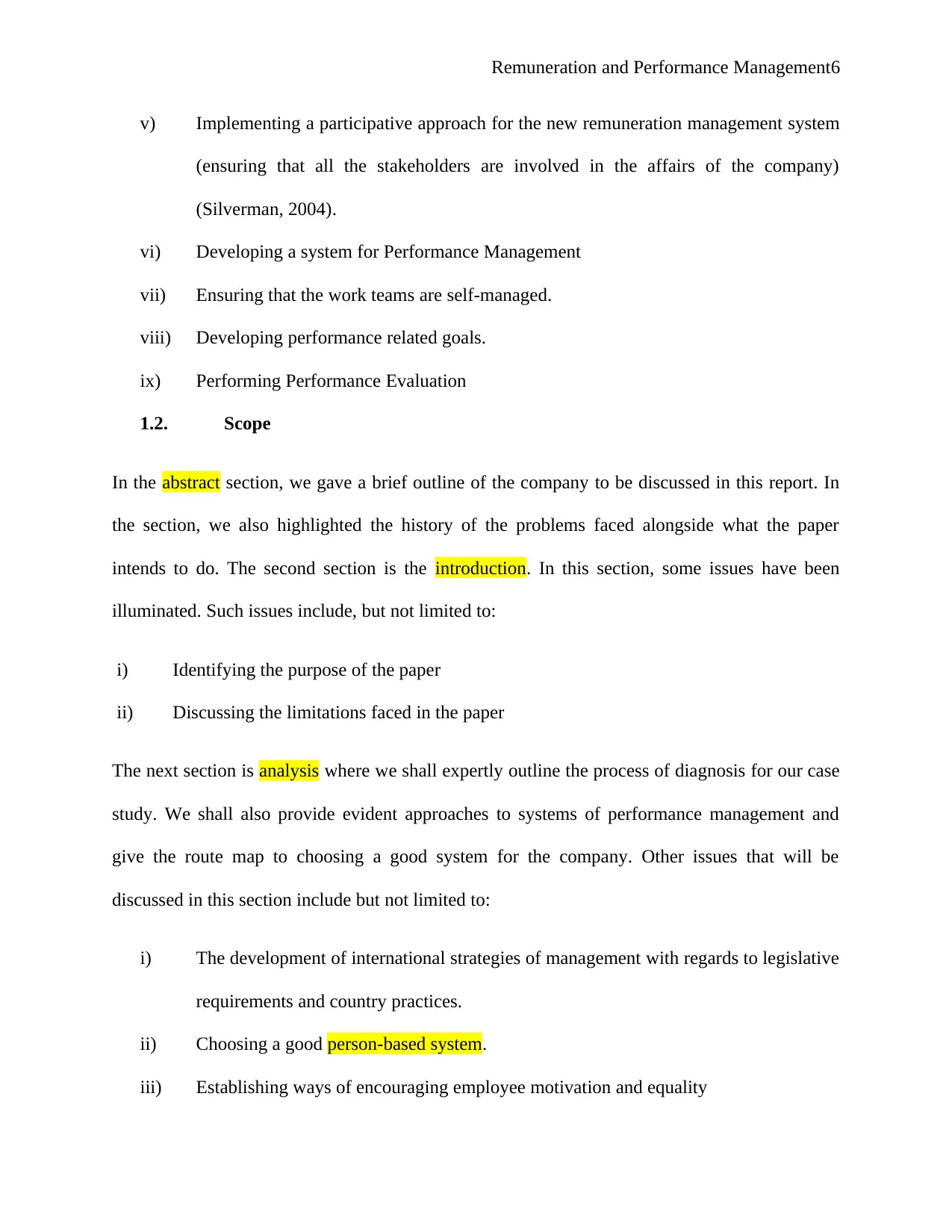
Remuneration and Performance Management6
v) Implementing a participative approach for the new remuneration management system
(ensuring that all the stakeholders are involved in the affairs of the company)
(Silverman, 2004).
vi) Developing a system for Performance Management
vii) Ensuring that the work teams are self-managed.
viii) Developing performance related goals.
ix) Performing Performance Evaluation
1.2. Scope
In the abstract section, we gave a brief outline of the company to be discussed in this report. In
the section, we also highlighted the history of the problems faced alongside what the paper
intends to do. The second section is the introduction. In this section, some issues have been
illuminated. Such issues include, but not limited to:
i) Identifying the purpose of the paper
ii) Discussing the limitations faced in the paper
The next section is analysis where we shall expertly outline the process of diagnosis for our case
study. We shall also provide evident approaches to systems of performance management and
give the route map to choosing a good system for the company. Other issues that will be
discussed in this section include but not limited to:
i) The development of international strategies of management with regards to legislative
requirements and country practices.
ii) Choosing a good person-based system.
iii) Establishing ways of encouraging employee motivation and equality
v) Implementing a participative approach for the new remuneration management system
(ensuring that all the stakeholders are involved in the affairs of the company)
(Silverman, 2004).
vi) Developing a system for Performance Management
vii) Ensuring that the work teams are self-managed.
viii) Developing performance related goals.
ix) Performing Performance Evaluation
1.2. Scope
In the abstract section, we gave a brief outline of the company to be discussed in this report. In
the section, we also highlighted the history of the problems faced alongside what the paper
intends to do. The second section is the introduction. In this section, some issues have been
illuminated. Such issues include, but not limited to:
i) Identifying the purpose of the paper
ii) Discussing the limitations faced in the paper
The next section is analysis where we shall expertly outline the process of diagnosis for our case
study. We shall also provide evident approaches to systems of performance management and
give the route map to choosing a good system for the company. Other issues that will be
discussed in this section include but not limited to:
i) The development of international strategies of management with regards to legislative
requirements and country practices.
ii) Choosing a good person-based system.
iii) Establishing ways of encouraging employee motivation and equality
⊘ This is a preview!⊘
Do you want full access?
Subscribe today to unlock all pages.

Trusted by 1+ million students worldwide
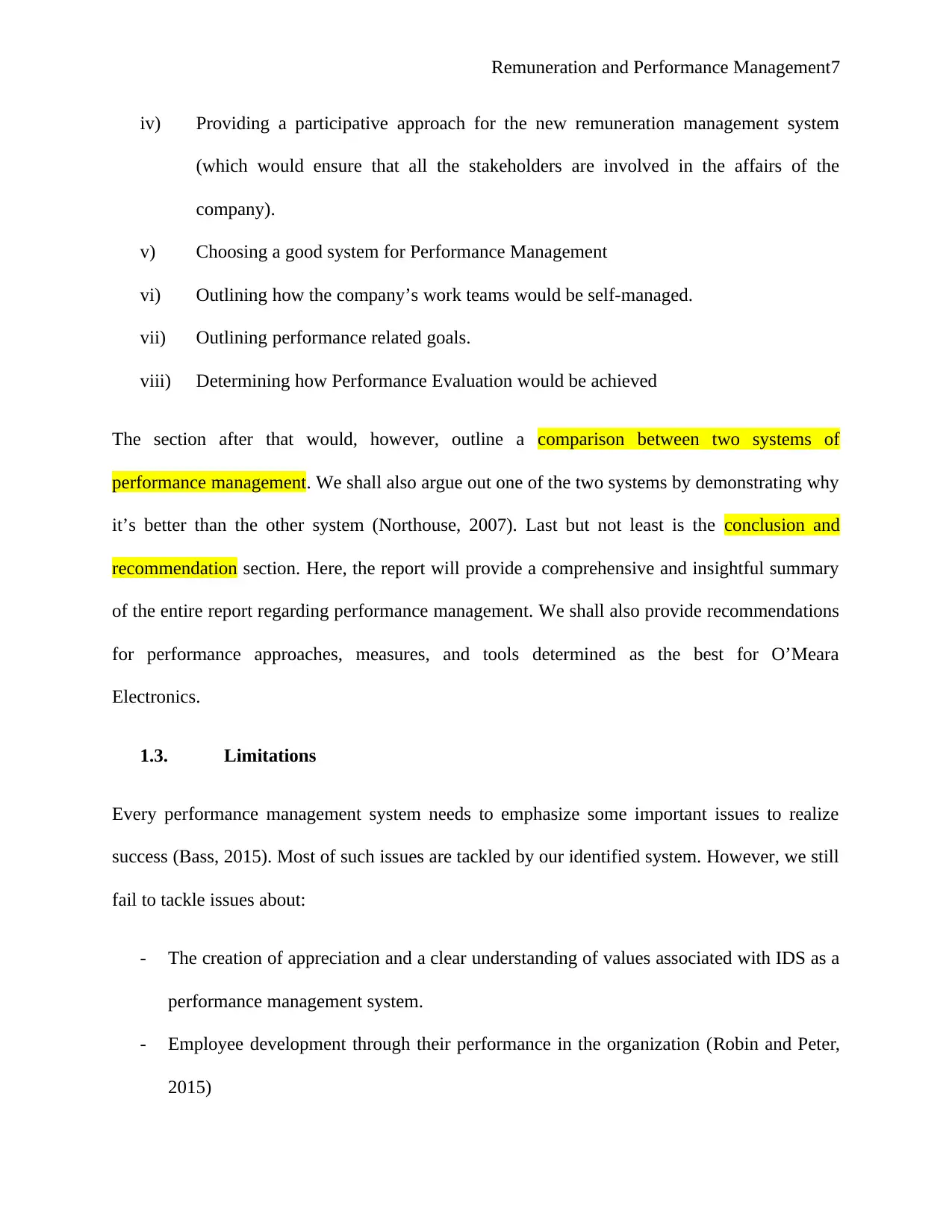
Remuneration and Performance Management7
iv) Providing a participative approach for the new remuneration management system
(which would ensure that all the stakeholders are involved in the affairs of the
company).
v) Choosing a good system for Performance Management
vi) Outlining how the company’s work teams would be self-managed.
vii) Outlining performance related goals.
viii) Determining how Performance Evaluation would be achieved
The section after that would, however, outline a comparison between two systems of
performance management. We shall also argue out one of the two systems by demonstrating why
it’s better than the other system (Northouse, 2007). Last but not least is the conclusion and
recommendation section. Here, the report will provide a comprehensive and insightful summary
of the entire report regarding performance management. We shall also provide recommendations
for performance approaches, measures, and tools determined as the best for O’Meara
Electronics.
1.3. Limitations
Every performance management system needs to emphasize some important issues to realize
success (Bass, 2015). Most of such issues are tackled by our identified system. However, we still
fail to tackle issues about:
- The creation of appreciation and a clear understanding of values associated with IDS as a
performance management system.
- Employee development through their performance in the organization (Robin and Peter,
2015)
iv) Providing a participative approach for the new remuneration management system
(which would ensure that all the stakeholders are involved in the affairs of the
company).
v) Choosing a good system for Performance Management
vi) Outlining how the company’s work teams would be self-managed.
vii) Outlining performance related goals.
viii) Determining how Performance Evaluation would be achieved
The section after that would, however, outline a comparison between two systems of
performance management. We shall also argue out one of the two systems by demonstrating why
it’s better than the other system (Northouse, 2007). Last but not least is the conclusion and
recommendation section. Here, the report will provide a comprehensive and insightful summary
of the entire report regarding performance management. We shall also provide recommendations
for performance approaches, measures, and tools determined as the best for O’Meara
Electronics.
1.3. Limitations
Every performance management system needs to emphasize some important issues to realize
success (Bass, 2015). Most of such issues are tackled by our identified system. However, we still
fail to tackle issues about:
- The creation of appreciation and a clear understanding of values associated with IDS as a
performance management system.
- Employee development through their performance in the organization (Robin and Peter,
2015)
Paraphrase This Document
Need a fresh take? Get an instant paraphrase of this document with our AI Paraphraser
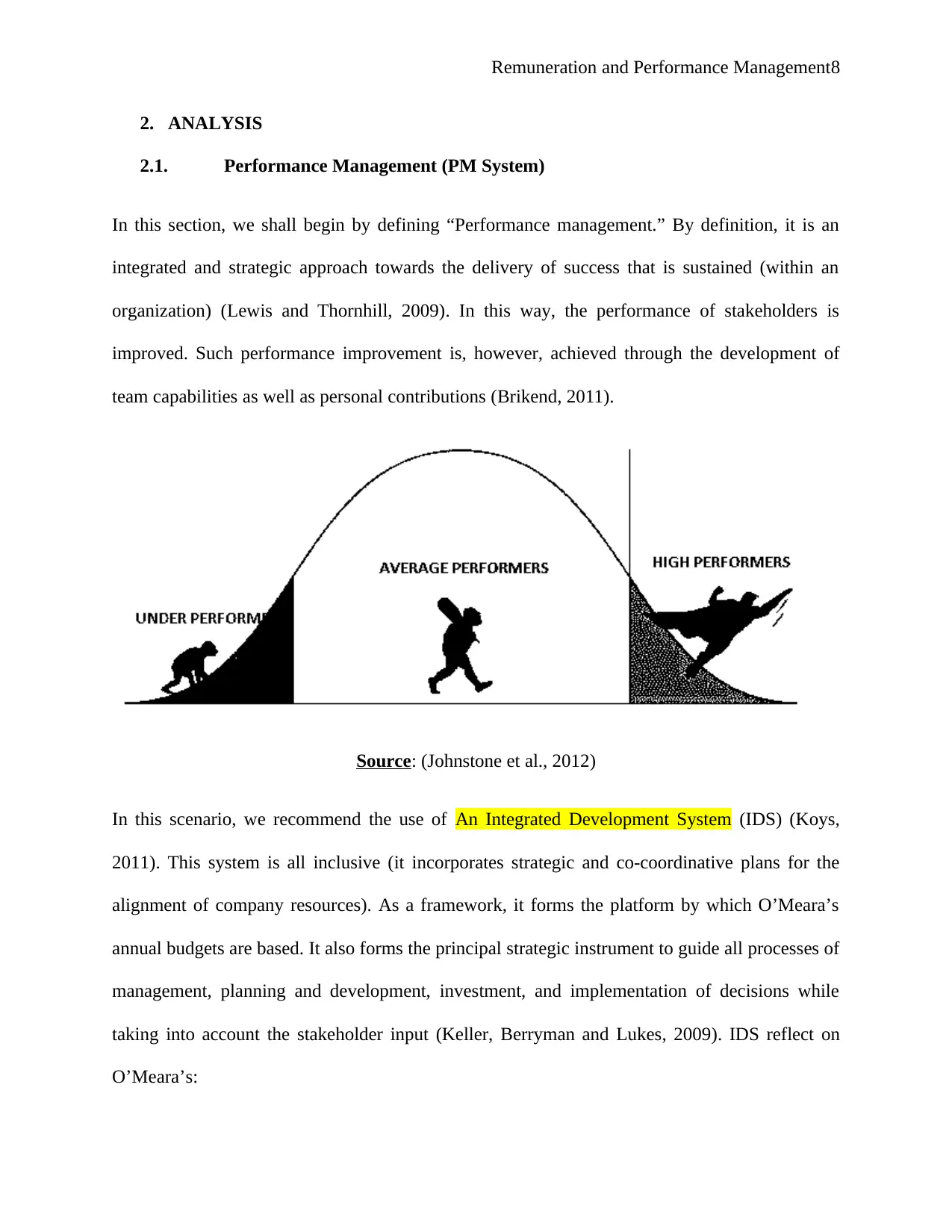
Remuneration and Performance Management8
2. ANALYSIS
2.1. Performance Management (PM System)
In this section, we shall begin by defining “Performance management.” By definition, it is an
integrated and strategic approach towards the delivery of success that is sustained (within an
organization) (Lewis and Thornhill, 2009). In this way, the performance of stakeholders is
improved. Such performance improvement is, however, achieved through the development of
team capabilities as well as personal contributions (Brikend, 2011).
Source: (Johnstone et al., 2012)
In this scenario, we recommend the use of An Integrated Development System (IDS) (Koys,
2011). This system is all inclusive (it incorporates strategic and co-coordinative plans for the
alignment of company resources). As a framework, it forms the platform by which O’Meara’s
annual budgets are based. It also forms the principal strategic instrument to guide all processes of
management, planning and development, investment, and implementation of decisions while
taking into account the stakeholder input (Keller, Berryman and Lukes, 2009). IDS reflect on
O’Meara’s:
2. ANALYSIS
2.1. Performance Management (PM System)
In this section, we shall begin by defining “Performance management.” By definition, it is an
integrated and strategic approach towards the delivery of success that is sustained (within an
organization) (Lewis and Thornhill, 2009). In this way, the performance of stakeholders is
improved. Such performance improvement is, however, achieved through the development of
team capabilities as well as personal contributions (Brikend, 2011).
Source: (Johnstone et al., 2012)
In this scenario, we recommend the use of An Integrated Development System (IDS) (Koys,
2011). This system is all inclusive (it incorporates strategic and co-coordinative plans for the
alignment of company resources). As a framework, it forms the platform by which O’Meara’s
annual budgets are based. It also forms the principal strategic instrument to guide all processes of
management, planning and development, investment, and implementation of decisions while
taking into account the stakeholder input (Keller, Berryman and Lukes, 2009). IDS reflect on
O’Meara’s:
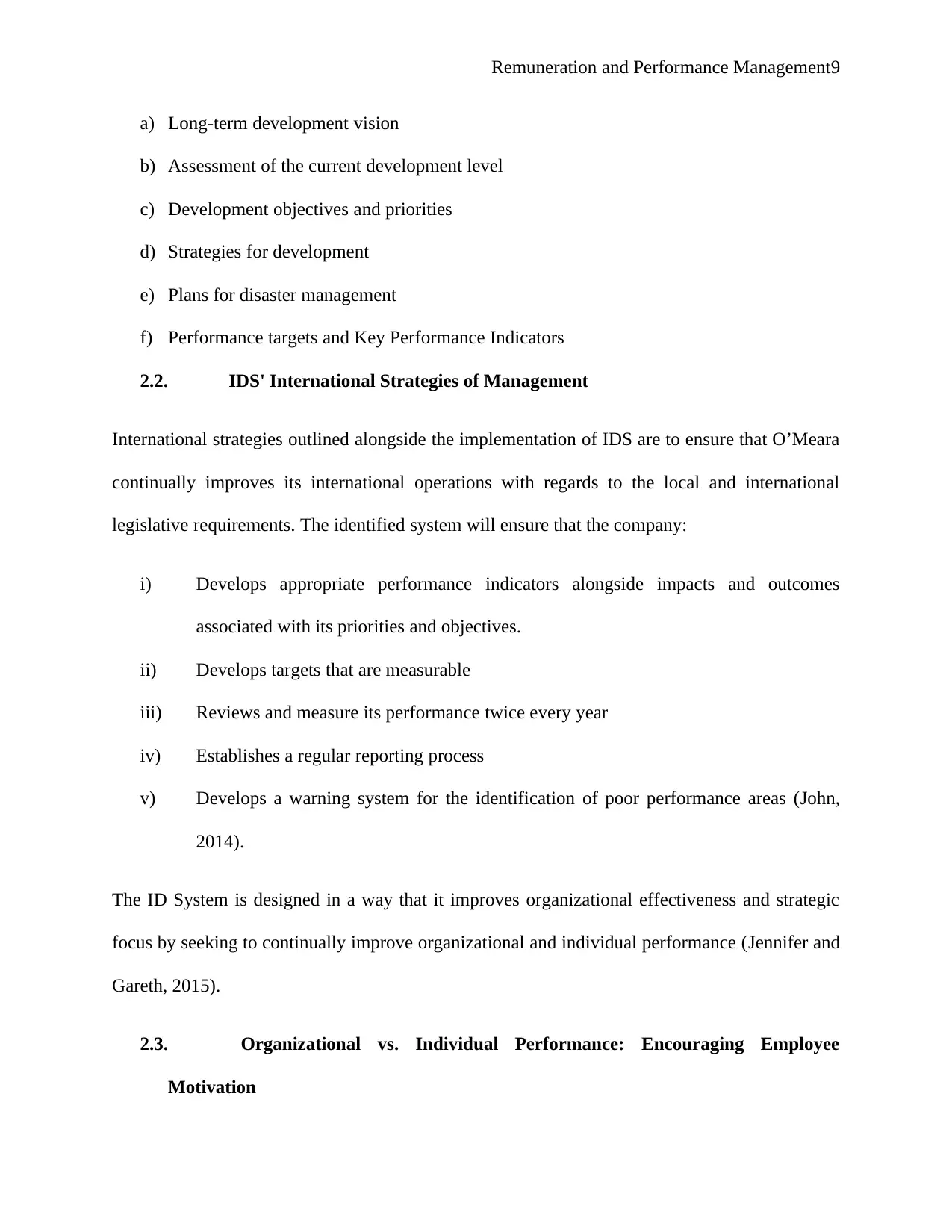
Remuneration and Performance Management9
a) Long-term development vision
b) Assessment of the current development level
c) Development objectives and priorities
d) Strategies for development
e) Plans for disaster management
f) Performance targets and Key Performance Indicators
2.2. IDS' International Strategies of Management
International strategies outlined alongside the implementation of IDS are to ensure that O’Meara
continually improves its international operations with regards to the local and international
legislative requirements. The identified system will ensure that the company:
i) Develops appropriate performance indicators alongside impacts and outcomes
associated with its priorities and objectives.
ii) Develops targets that are measurable
iii) Reviews and measure its performance twice every year
iv) Establishes a regular reporting process
v) Develops a warning system for the identification of poor performance areas (John,
2014).
The ID System is designed in a way that it improves organizational effectiveness and strategic
focus by seeking to continually improve organizational and individual performance (Jennifer and
Gareth, 2015).
2.3. Organizational vs. Individual Performance: Encouraging Employee
Motivation
a) Long-term development vision
b) Assessment of the current development level
c) Development objectives and priorities
d) Strategies for development
e) Plans for disaster management
f) Performance targets and Key Performance Indicators
2.2. IDS' International Strategies of Management
International strategies outlined alongside the implementation of IDS are to ensure that O’Meara
continually improves its international operations with regards to the local and international
legislative requirements. The identified system will ensure that the company:
i) Develops appropriate performance indicators alongside impacts and outcomes
associated with its priorities and objectives.
ii) Develops targets that are measurable
iii) Reviews and measure its performance twice every year
iv) Establishes a regular reporting process
v) Develops a warning system for the identification of poor performance areas (John,
2014).
The ID System is designed in a way that it improves organizational effectiveness and strategic
focus by seeking to continually improve organizational and individual performance (Jennifer and
Gareth, 2015).
2.3. Organizational vs. Individual Performance: Encouraging Employee
Motivation
⊘ This is a preview!⊘
Do you want full access?
Subscribe today to unlock all pages.

Trusted by 1+ million students worldwide
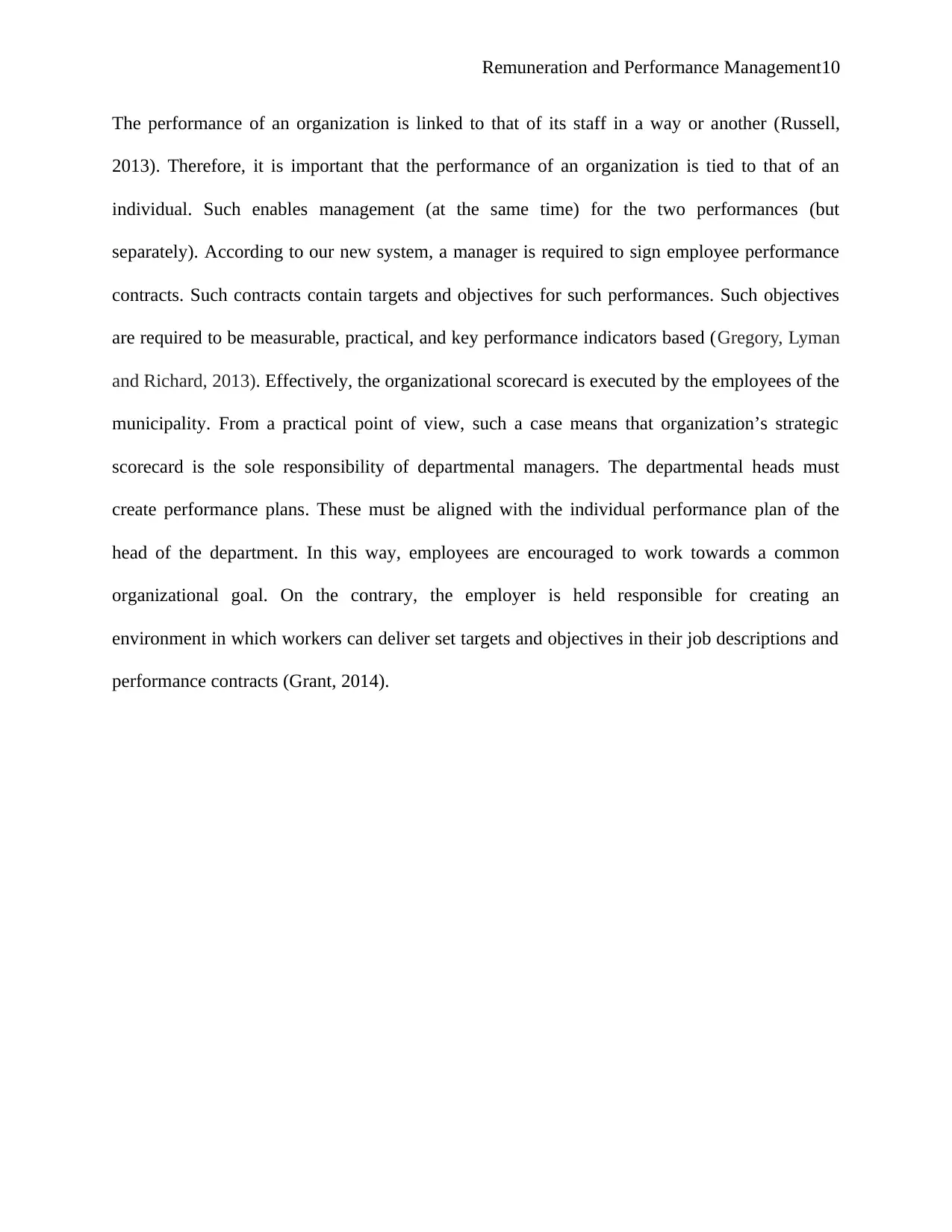
Remuneration and Performance Management10
The performance of an organization is linked to that of its staff in a way or another (Russell,
2013). Therefore, it is important that the performance of an organization is tied to that of an
individual. Such enables management (at the same time) for the two performances (but
separately). According to our new system, a manager is required to sign employee performance
contracts. Such contracts contain targets and objectives for such performances. Such objectives
are required to be measurable, practical, and key performance indicators based (Gregory, Lyman
and Richard, 2013). Effectively, the organizational scorecard is executed by the employees of the
municipality. From a practical point of view, such a case means that organization’s strategic
scorecard is the sole responsibility of departmental managers. The departmental heads must
create performance plans. These must be aligned with the individual performance plan of the
head of the department. In this way, employees are encouraged to work towards a common
organizational goal. On the contrary, the employer is held responsible for creating an
environment in which workers can deliver set targets and objectives in their job descriptions and
performance contracts (Grant, 2014).
The performance of an organization is linked to that of its staff in a way or another (Russell,
2013). Therefore, it is important that the performance of an organization is tied to that of an
individual. Such enables management (at the same time) for the two performances (but
separately). According to our new system, a manager is required to sign employee performance
contracts. Such contracts contain targets and objectives for such performances. Such objectives
are required to be measurable, practical, and key performance indicators based (Gregory, Lyman
and Richard, 2013). Effectively, the organizational scorecard is executed by the employees of the
municipality. From a practical point of view, such a case means that organization’s strategic
scorecard is the sole responsibility of departmental managers. The departmental heads must
create performance plans. These must be aligned with the individual performance plan of the
head of the department. In this way, employees are encouraged to work towards a common
organizational goal. On the contrary, the employer is held responsible for creating an
environment in which workers can deliver set targets and objectives in their job descriptions and
performance contracts (Grant, 2014).
Paraphrase This Document
Need a fresh take? Get an instant paraphrase of this document with our AI Paraphraser
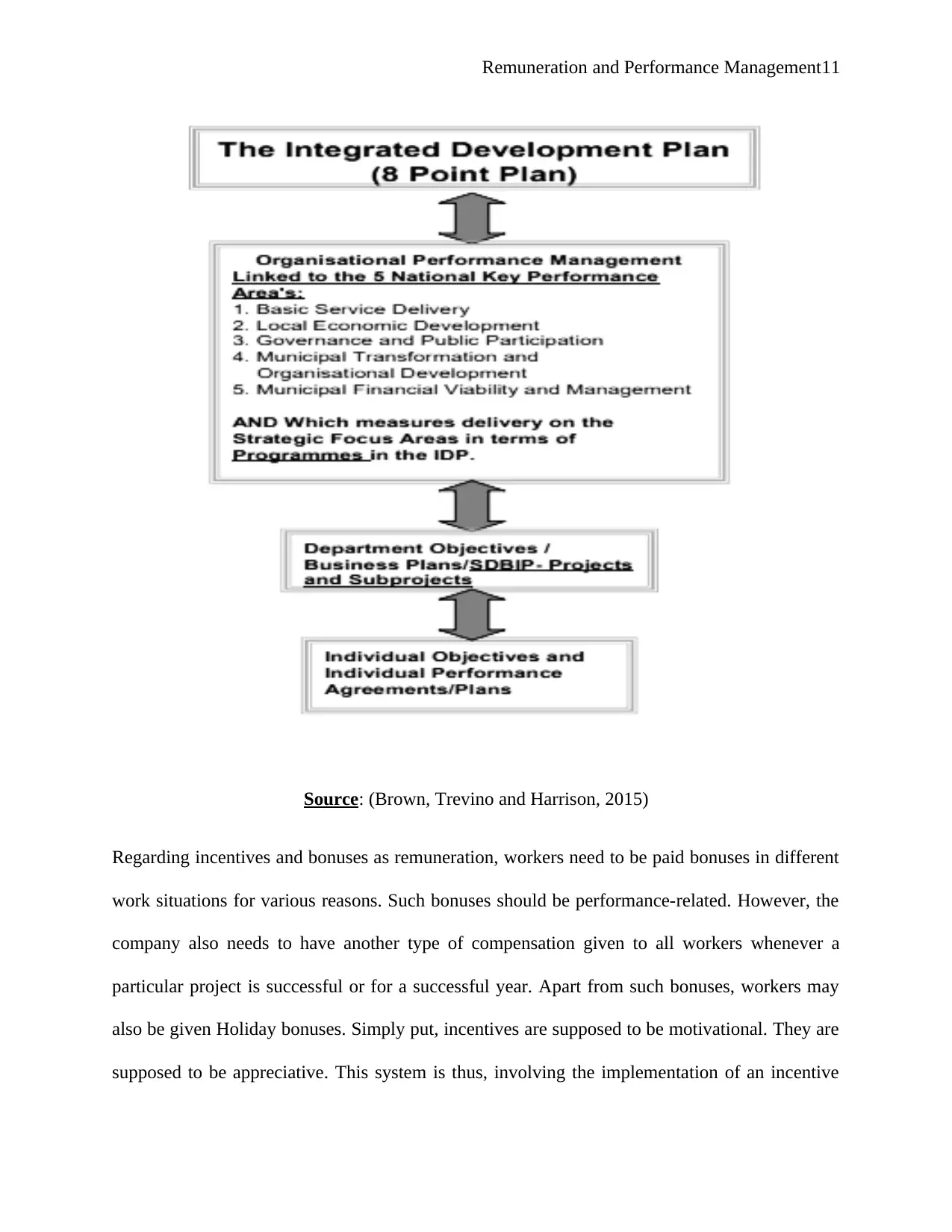
Remuneration and Performance Management11
Source: (Brown, Trevino and Harrison, 2015)
Regarding incentives and bonuses as remuneration, workers need to be paid bonuses in different
work situations for various reasons. Such bonuses should be performance-related. However, the
company also needs to have another type of compensation given to all workers whenever a
particular project is successful or for a successful year. Apart from such bonuses, workers may
also be given Holiday bonuses. Simply put, incentives are supposed to be motivational. They are
supposed to be appreciative. This system is thus, involving the implementation of an incentive
Source: (Brown, Trevino and Harrison, 2015)
Regarding incentives and bonuses as remuneration, workers need to be paid bonuses in different
work situations for various reasons. Such bonuses should be performance-related. However, the
company also needs to have another type of compensation given to all workers whenever a
particular project is successful or for a successful year. Apart from such bonuses, workers may
also be given Holiday bonuses. Simply put, incentives are supposed to be motivational. They are
supposed to be appreciative. This system is thus, involving the implementation of an incentive
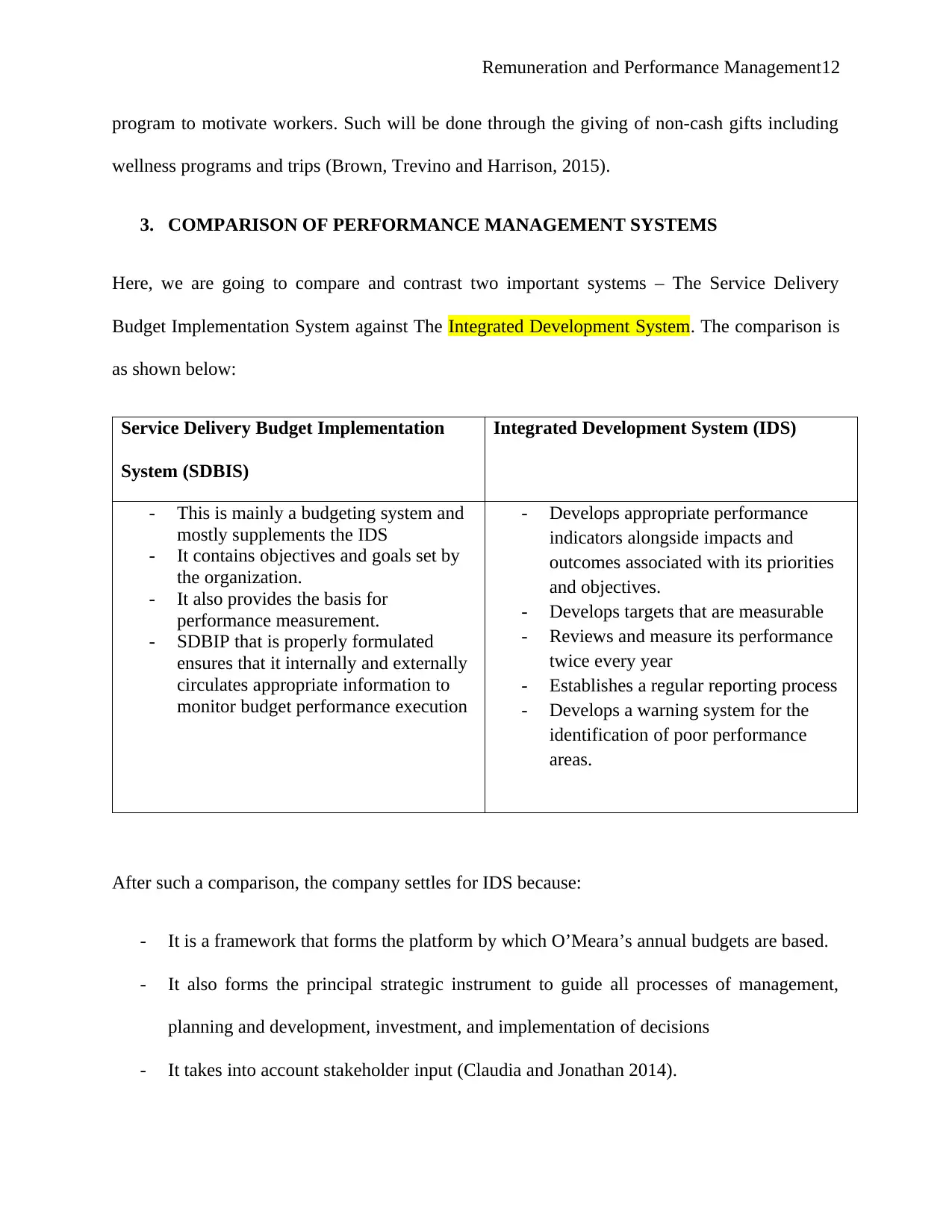
Remuneration and Performance Management12
program to motivate workers. Such will be done through the giving of non-cash gifts including
wellness programs and trips (Brown, Trevino and Harrison, 2015).
3. COMPARISON OF PERFORMANCE MANAGEMENT SYSTEMS
Here, we are going to compare and contrast two important systems – The Service Delivery
Budget Implementation System against The Integrated Development System. The comparison is
as shown below:
Service Delivery Budget Implementation
System (SDBIS)
Integrated Development System (IDS)
- This is mainly a budgeting system and
mostly supplements the IDS
- It contains objectives and goals set by
the organization.
- It also provides the basis for
performance measurement.
- SDBIP that is properly formulated
ensures that it internally and externally
circulates appropriate information to
monitor budget performance execution
- Develops appropriate performance
indicators alongside impacts and
outcomes associated with its priorities
and objectives.
- Develops targets that are measurable
- Reviews and measure its performance
twice every year
- Establishes a regular reporting process
- Develops a warning system for the
identification of poor performance
areas.
After such a comparison, the company settles for IDS because:
- It is a framework that forms the platform by which O’Meara’s annual budgets are based.
- It also forms the principal strategic instrument to guide all processes of management,
planning and development, investment, and implementation of decisions
- It takes into account stakeholder input (Claudia and Jonathan 2014).
program to motivate workers. Such will be done through the giving of non-cash gifts including
wellness programs and trips (Brown, Trevino and Harrison, 2015).
3. COMPARISON OF PERFORMANCE MANAGEMENT SYSTEMS
Here, we are going to compare and contrast two important systems – The Service Delivery
Budget Implementation System against The Integrated Development System. The comparison is
as shown below:
Service Delivery Budget Implementation
System (SDBIS)
Integrated Development System (IDS)
- This is mainly a budgeting system and
mostly supplements the IDS
- It contains objectives and goals set by
the organization.
- It also provides the basis for
performance measurement.
- SDBIP that is properly formulated
ensures that it internally and externally
circulates appropriate information to
monitor budget performance execution
- Develops appropriate performance
indicators alongside impacts and
outcomes associated with its priorities
and objectives.
- Develops targets that are measurable
- Reviews and measure its performance
twice every year
- Establishes a regular reporting process
- Develops a warning system for the
identification of poor performance
areas.
After such a comparison, the company settles for IDS because:
- It is a framework that forms the platform by which O’Meara’s annual budgets are based.
- It also forms the principal strategic instrument to guide all processes of management,
planning and development, investment, and implementation of decisions
- It takes into account stakeholder input (Claudia and Jonathan 2014).
⊘ This is a preview!⊘
Do you want full access?
Subscribe today to unlock all pages.

Trusted by 1+ million students worldwide
1 out of 16
Related Documents
Your All-in-One AI-Powered Toolkit for Academic Success.
+13062052269
info@desklib.com
Available 24*7 on WhatsApp / Email
![[object Object]](/_next/static/media/star-bottom.7253800d.svg)
Unlock your academic potential
Copyright © 2020–2025 A2Z Services. All Rights Reserved. Developed and managed by ZUCOL.





